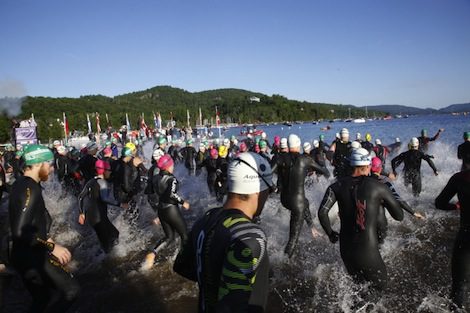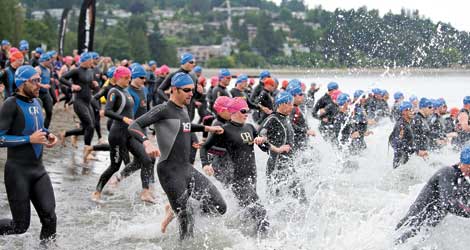Spring Training: Olympic Distance Preparation
The spring is always an exciting time for triathlon training in Canada.

 The spring is always an exciting time for triathlon training in Canada as winter is finally over and we start to get the first taste of summer. This is the time to start incorporating some race-specific training into your plan in order to fine tune your fitness and be ready to go for your summer races. Depending on when your ‘A’ race falls, April and May should include some race specific work as well as increased volume. The approach will vary depending on the ability of the athlete:
The spring is always an exciting time for triathlon training in Canada as winter is finally over and we start to get the first taste of summer. This is the time to start incorporating some race-specific training into your plan in order to fine tune your fitness and be ready to go for your summer races. Depending on when your ‘A’ race falls, April and May should include some race specific work as well as increased volume. The approach will vary depending on the ability of the athlete:
Beginner Athlete: The key is to build your fitness so that you can comfortably complete the distances of your ‘A’ race in each sport on its own. That means being able to swim 1500m, bike 40km and run 10km, but not consecutively. The focus during the spring will be to build your endurance.
Experienced Athlete: If you are looking to improve your performance, the key in this period is to raise your functional threshold speed (improve your pace and power for an all-out 60 minute effort in one sport). You should also plan on getting in a few ‘C’ races to into the groove of racing again.
Here are some things you should think about adding to your spring training plan to be ready for your summer races:
Volume: As the weather gets nicer, it is time to build up a bit of volume, especially on the bike. For those who have spent most of the winter on the indoor trainer, this is the time to get back out on the road and get used to wind, hills and potholes again. Beginner athletes will want to build up to riding 40- to 50 km as your long ride, while more experienced athletes can build up to long rides of 60 to 80 km or more. On the run, beginner athletes should aim to build up to 10km, while more experienced athletes should be build to a long run of over 15 km. In the water, your goal should be to add some continuous swimming. The beginner athlete should work up to 1,500 m without stopping, while the more experienced athlete should be do a regular 1,500m hard swim and aim to and improve his their time.

Races: The spring is a great time to enter some ‘C’ races. These will help, not only in terms of fitness, but also to get used to the hard effort and focus needed to race well. There are many different options; here are a few to consider:
- Time Trials: Many local bike clubs and shops offer weekly time trials. These are a chance to work really hard on the bike over shorter distances (usually 10 to 15 km). Even over these shorter distances, however, pacing is still important and is a key aspect of any race you do. The power data from races like these can also help you set out power numbers for your ‘A’ races in the summer.
- Running Races: 5 to 10 km running races are a great way to get in some speed work as well as to test your fitness. They can also give you an idea of your pacing for the triathlon season.
- Masters Swim Meets: Local masters swim meets provide a chance to try different distances and to work on some top end speed for your race starts.
- Duathlons: The duathlon season usually starts earlier in the spring. These are great races as they help you get used to the bike/run transition. Remember, though, that it is helpful to do a few run/bike workouts before these races as it’s a lot different to run hard and then ride, than it is to swim first and then get on the bike!
Brick Workouts: Bricks (bike-run workouts) are a great way to get in some race specific training and there are different ways to do them. Here are a few ideas:
- Long Ride/Run: After your long rides you should be hopping off the bike and going for a short run (20 to 40 minutes). This run doesn’t need to be hard or fast, just comfortable. It is a chance to build endurance and to train yourself to run on tired legs. Getting used to the feeling of running after riding is a key workout for the beginner athlete.
- Bike/Run intervals: This is a more advanced workout and is ideally done on the road. A quiet loop with little traffic is what you are looking for. A great brick workout is 3 x (10 min bike/ 5 min run) with a 4 minute jog or easy spin between each interval. The intervals are done hard with the goal of holding the same power and pace across all three intervals. This can also be done on your indoor trainer and then running around the block, or even taking your trainer to the track and running around the track. This is a great workout to build your functional threshold and to work on pacing and running hard off of the bike
- Swim/Bike intervals: This is a workout that most athletes neglect, but if you have a good relationship with your local pool it is something that is easily done. Bring your bike and indoor trainer to the pool, set it up on the deck and you can do some swim/bike intervals. A great workout for this is 5 x (200 to 300m swim/8 min bike) with 3 minutes easy spinning in between.
As spring comes to Canada most athletes start to see an increase in their motivation along with the increase in temperature. This is a good time to put in some hard training and some more race- specific work. Just make sure you balance the increased training and racing load with the appropriate amount of recovery; you are not quite in your race season yet and you want to make sure that you are both fit and fresh for when your goal races start!
Nigel Gray is the Head Coach of NRG Performance Training, with over 13 years of coaching experience from beginners to Elite athletes and 18 years of racing experience as a Professional Triathlete.
